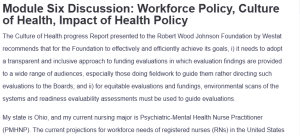Module Six Discussion: Workforce Policy, Culture of Health, Impact of Health Policy
The Culture of Health progress Report presented to the Robert Wood Johnson Foundation by Westat recommends that for the Foundation to effectively and efficiently achieve its goals, i) it needs to adopt a transparent and inclusive approach to funding evaluations in which evaluation findings are provided to a wide range of audiences, especially those doing fieldwork to guide them rather directing such evaluations to the Boards; and ii) for equitable evaluations and fundings, environmental scans of the systems and readiness evaluability assessments must be used to guide evaluations.
My state is Ohio, and my current nursing major is Psychiatric-Mental Health Nurse Practitioner (PMHNP). The current projections for workforce needs of registered nurses (RNs) in the United States highlight significant shortages both at the national and state levels. At the national level, the RN workforce is projected to grow from 3.1 million to 3.3 million between 2022 and 2032 (American Association of Colleges of Nursing (AACN), 2024). At the same time, reports show that 100,000 RNs left the workforce during the COVID-19 pandemic, with 610,388 RNs more reporting intention to leave by 2027 and further a fifth of the RN workforce projected to leave the RN workforce (NCSBN, 2023). Such projections indicate a looming RN shortage in the near future.
In Ohio, although seven out of ten nurses consider leaving direct care (Day, 2023), it is projected that the demand for RNs by 2030 in Ohio will grow to 132,800 with a total supply of 181,900. This is in excess of 49,100 RNs. Still, the demand for mental health NPs is growing, especially with the post-COVID-19 pandemic mental health crisis.
Addressing the RN workforce issues, such as intentions to leave and the growing RN shortages, requires the adoption of strategies targeting the causes of such issues, including poor pay, improving workplace conditions, reducing workload, and improving nurse education capacity through education grants.
References
American Association of Colleges of Nursing (AACN). (2024, May). Nursing shortage fact sheet. https://www.aacnnursing.org/news-data/fact-sheets/nursing-shortage
Day, M. (2023, November 6). Ohio Nurses Association announces Safe Staffing Standards Bill. Ohio Nurses Association. https://ohnurses.org/ohio-nurses-association-announces-safe-staffing-standards-bill/
NCSBN. (2023, April 13). NCSBN Research Projects Significant nursing workforce shortages and crisis. www.ncsbn.org. https://www.ncsbn.org/news/ncsbn-research-projects-significant-nursing-workforce-shortages-and-crisis
ORDER A PLAGIARISM-FREE PAPER HERE
We’ll write everything from scratch
Question 
The focus of this assignment is for you to gain insight to current or recent legislation. Further, the goal is for you to dialogue with others regarding contemporary legislation and its potential impact.
AND
Another focus of this assignment is for you to read key health care policy documents and reflect on crucial issues discussed and apply that knowledge to your professional practice.
You can find the general Discussion Board Guidelines by clicking this link. These guidelines apply to all Discussion Board assignments in this course.

Module Six Discussion: Workforce Policy, Culture of Health, Impact of Health Policy
Discussion Items:
- Post the abstract from your health policy analysis paper abstract here. Remember the abstract should be written according to APA.
- Comment on at least one of your peer’s analysis paper abstract. The response should be a minimum of one paragraph or approximately 50 words and should include comments and questions. The author of the Analysis Paper must respond to a minimum of one posted comment from a peer. If no peer comments on your abstract, a response is not possible and this is acceptable.
- After reading the Robert Wood Johnson (RWJ) Culture of Health Report, identify two specific recommendations found in the Culture of Health Report.
- After reviewing the workforce data in the required readings plus exploring information related to your state workforce, identify the following: 4A. Name your state, 4B. Name your current nursing major or specialty, 4 C. Share the national as well as your state projections for workforce needs for RNs as well as your specialty, 4D. Identify strategies for addressing the workforce findings identified in 4.C.
